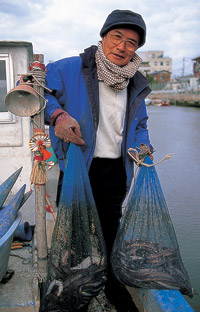|
Tokyo Bay is sheltered by the Boso and Miura peninsulas. Facing the bay are Tokyo, Yokohama and other metropolitan centers. The world's largest industrial zone spreads out around the bay. Many ports are located here as well, linking Japan to other countries. The bay opens up into the Pacific Ocean, and until the mid-1800s, it was an important fishing ground, supplying huge amounts of fresh fish to the nearby city of Edo (present-day Tokyo). Even today, many kinds of fish and shellfish inhabit the waters, some notable examples being haze (goby), suzuki (sea bass), kohada (gizzard shad), kisu (sillago) and shako (mantis crab). A variety of fishing methods are still used to catch them.
Haneda Airport faces the bay. A 67-year-old fisherman named Ito Toshitsugu lives just beside it, in Tokyo's ota City. He began working on a fishing boat when he was 15, following in the steps of his father and grandfather. He catches short-necked clams in the summer, flatfish in the winter, and sea eels all year long.
Sea eels are actually fish, long and thin like fresh-water eels. Their name in Japanese is anago, which comes from ana-no-ko (hole dwellers). They like holes on the sea bottom—during the day they sleep in them, and during the night they stick their heads out to eat. They can be caught in traps that imitate the environment they like.
At 10 a.m., Ito is getting his traps ready on a wharf near his home. The traps, called anago-zutsu, are basically plastic pipes 10 cm in diameter with many small holes to let baby fish escape. He places frozen sardines inside for bait, then fits a cone-shaped device into the end of each trap. The cone guides the eels along as it tapers down to a narrow hole, then traps them inside. Ito is going to drop the traps to the floor of the bay—then at night the sea eels will smell the sardines and meet their fate. The fishermen make all of their traps by hand, so there are subtle differences between them. 
|
 |

Ito Toshitsugu has been fishing for half a century. He lives near Haneda Airport with his wife and mother.
|